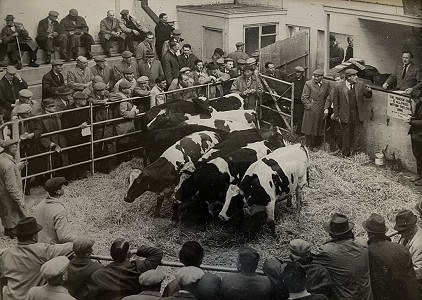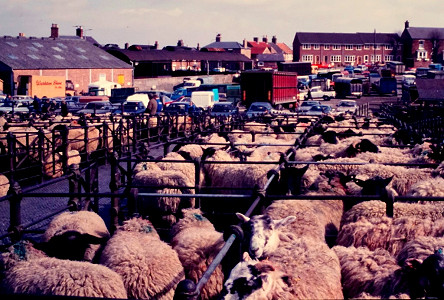Louth Livestock Market

Auction ring, with auctioneer Jim Laverack.

Sheep pens
Records of Louth Cattle Market Auctioneers in the 1960s and 70s give enough detailed information to fill a book. For this blog I shall pick out a few points.
Routine markets were held on the Newmarket site every Friday, with additional special markets for store cattle, breeding sheep, etc. The markets were run by a partnership of five local firms: Masons; John Taylors; Young & Boulton (in Alford); Dickinson, Davy & Markham; and Broadgate & Thompson. The chairman was Mr R M ‘Dick’ Chatterton of Masons. Today, the markets are run solely by Masons, and the weekly market is on Monday – a more convenient day for butchers to slaughter and process the meat.
The numbers of animals sold in 1968 were approximately 19,000 cattle, 41,000 sheep and 16,000 pigs. That’s a lot, an average of 1,500 animals passing through the market each week. Louth Cattle Market was a busy place. Most animals were either ‘stores’ (reared and ready to be fattened), ‘fat’ (ready for slaughter), or young female breeding stock: ‘heifers’, ‘gimmers’ and ‘gilts’. The purchasers were farmers buying animals, livestock dealers who would transport animals to other areas, or butchers.
Between 1968 and 1978, cattle numbers rose slightly, sheep numbers halved, and pig numbers fell dramatically. The fall in pig numbers was associated with changes in production systems - small pig producers were being replaced by large commercial units that had contracts with meat processing companies.
Last year (2024) the total numbers were 2,000 cattle, 23,000 sheep and no pigs. Louth is the only remaining functioning livestock market in Lincolnshire. Our historic market is of importance to the local economy, and convenient for small-scale farmers, but from the animal welfare point of view, the journey to market, the stress in unfamiliar surroundings and the onward journey is open to criticism.
During the 1960s and 1970s, the market had to cope with various challenges:
• Brucellosis accreditation and eradication. Eradicated in cattle in 2004.
• Swine vesicular disease (SVD), a viral disease of pigs, with similar symptoms to foot-and-mouth disease. Eradicated in 1982.
• Warble Fly, 1978, which cause painful swellings on the back of cattle. Eradicated in 1990.
• Sheep Scab Order 1978, requiring all sheep to be dipped with a licensed chemical.
• VAT, Value Added Tax, came into effect on 1 April 1973.
• Beef Premium and Fat Sheep Guarantee Schemes, provided financial incentives to farmers.
• Entry into the EEC and new regulations. The UK joined the EEC on 1 January 1973.
• Health and Safety at Work Act 1974, outlined responsibilities to ensure workplace health, safety, and welfare.
There is a description of the build-up to Decimal Day which was 15 February 1971, when decimal currency was introduced, and we started using pounds and (new) pence instead of pounds, shillings, and pence. Nowadays the decimal system seems straightforward, but at that time there was anxiety about how the market staff would cope. Practice markets were held to familiarise auctioneers and staff with the use of decimal currency. Each firm provided dummy information, the auctioneers ‘sold’ a few lots, each member of staff booked the lots, made out bills and sales accounts, deducted the appropriate commission, and balanced the sales.